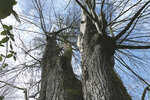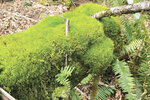


The wren is basically a mouse. It weaves through ferns. Then it appears on a stump not 10 feet away. It glances at us and, without a second thought, goes about its inspection of the stump’s terrain of moss. Has it ever seen a human?
A young maple’s 20 trunks shake overhead in restless spring air. It took some doing to get to this place deep in the new Pentheroudakis Preserve, a 22-acre forest near the southern tip of the peninsula. The only paths are deer trails, and they have a freaky way of appearing and disappearing, meandering on contours, dumping you into thickets.
This land was logged a few decades ago. I don’t think it was replanted. Everywhere are these maples, each with a profusion of trunks springing from and swallowing the stump left behind. Unlike conifers, maples respond to wounds by sprouting, and four years after being cut a maple can top 20 feet. These are more like 60 feet. Here and there are young fir, alder and bitter cherry. In places the understory is open, littered with last year’s leaves. In others it is lost in huckleberry, blackberry, sword fern, bathed in light, fighting. It is an adolescent forest just beginning, like a scrappy high schooler, to offer glimpses of its adulthood.
Winding along its spine is a creek where cedar and hemlock escaped the saw. Water links this preserve with the larger Johnson South Sound Preserve to the south, where an undeveloped lagoon holds some of the peninsula’s best fish habitat. The creek and its large conifers form a band narrow enough it is often exposed to the invasion of post-clearcut plants.
Yet this is the beauty of tramping without trails: when you do finally duck into a creekside space and realize you are surrounded by trunks fit for a national park, where tannic brown water murmurs around humps of logs that have become soil, it is a true discovery. Had you arrived by trail, the living log you climbed over — those young cedars, you realize with a start, are growing from the log, not on it — would be nothing but a curiosity, shined to a polish by the jeans of picnickers. In this way it is a mind-bender, a reminder that life has pulses far beyond the human grasp.
When I came here with the land’s donor, Joseph Pentheroudakis, a regular contributor to KP News, he shared stories and speculation about Charles Taylor, the first permanent settler on the peninsula, long a magnet of local myth. This was once part of Taylor’s homestead. Pentheroudakis shared what he has gleaned of Taylor’s life and life generally for the earliest homesteaders, his labor of love.
“Our past is their present,” he said.
We paused often to admire the sunken ships of stumps buried in moss and lichens. For the trees that survive here, our past and present are their present. Our future too. Our descendants’ future.
Today I am here with my friend, the landscape painter Emma Webster. Recently, fishing for fresh perspective on her massive monochromatic landscapes, in which clouds grasp and light strikes in bewildering ways, she asked a group of us to describe places where our sense of scale is tricked, or time becomes distorted.
My response was to bring her here. At first, following me carefully, she confesses that she feels like a tourist in nature.
She does pick up on the unseasonal crunch of maple leaves underfoot. I tell her these leaves are prized by gardeners. Big-leaf maple has a profligate appetite, shedding and reabsorbing nutrients en masse each fall and spring, making it one of our best soil-building species.
When I turn and say, “You don’t have to follow me,” hoping she will move freely and explore, even take the lead, she does not know how to react. Later she tells me that my suggestion throws her, transforms her experience of the tromp.
Still she follows me, yet as she grows into the place, I sense her begin to pay attention. She draws analogies. The multi-stemmed maples are like sticks shoved into a corner of her studio, unruly, the outer stems falling. She goes to inspect them, finds young mosses reaching around their teenaged trunks. She says their tendrils make her think of character drawing: You’re supposed to follow the contours.
She often paints from models, clay dioramas or virtual realities, forcing people who see her work to confront the idea that our models, our images and predictions, become so central to our understanding of the world that they often replace the world itself. Above us a raven calls in the wind. The pathless sky, sculpted by wings, contoured by gusts — she stops and says it is ominous. Order and disorder. There is no clear path to return us to the road.
Maple limbs knock together like bones. In a decade or two they will be robed. Their cracked, calcium-rich bark is the Northwest’s ideal home for epiphytes. These are the draping tree-canopy communities of moss, licorice fern, and liverwort that make Olympic rainforests look so lush. Epiphytes can weigh four times as much as a maple’s own foliage, before any rainwater is added.
Lacking roots, mosses are good at pulling nutrients from the sky. High in Olympic canopies, the peat-like soils they create have recently been studied, and in a remarkable discovery it has been found that big-leaf maples have the ability to sprout roots from branches in their crowns to take advantage of these aerial soils. Also found is an enriched microhabitat around the base of a mature maple’s trunk: Water caught in its vast aerial gardens slowly slips down its watershed-shaped body, full of nutrients, tracing, depositing.
Such landscapes cannot be planned. They grow into themselves. And every now and then you find a wolf tree, one so massive, strange and gnarled it is landscape history unto itself. Here I see it from a distance, a crown of tight twisting limbs. Oak, strangely, is my first impression. We approach and find a double trunk, one snapped off halfway, the wound surrounded by tall shoots. A hole in the tree’s base, large shelf mushrooms. Death and life in confusion. The crown, seen again from directly beneath, high atop what is now clearly a maple, looks like nothing I have seen. Its life and body are a pathless story, each angle offering distortions. I cannot ask the loggers why they left it. Was it too freaky even for them?
A few yards away, coolness from creek mud, full of the first leaves of bittercress, offers a window back into the winding grove of cedar and hemlock. An owl calls from deeper in the preserve.
“It’s such an amazing place,” said Pentheroudakis. “So rich with life.”
UNDERWRITTEN BY THE FUND FOR NONPROFIT NEWS (NEWSMATCH) AT THE MIAMI FOUNDATION, THE ANGEL GUILD, ADVERTISERS, DONORS AND PEOPLE WHO SUPPORT INDEPENDENT, NONPROFIT LOCAL NEWS